In the realm of the Japanese Tea Ceremony, time slows down, and the world becomes a tranquil oasis. Like a delicate flower unfurling its petals, the ceremony unfolds with grace and precision, captivating all who partake in its ritualistic dance.
Rooted in Zen Buddhism, this ancient practice, known as Sadou, is a profound expression of harmony, respect, and mindfulness. As participants carefully prepare and serve matcha, a powdered green tea, they engage in a choreographed symphony of movements, each step a testament to the beauty and grace inherent in this centuries-old tradition.
From the meticulously crafted utensils to the serene atmosphere, every detail in the Tea Ceremony holds significance, creating an immersive experience that is both captivating and transformative.
Good To Know

- Tea ceremony originated in ancient Japan and is deeply rooted in Japanese culture.
- The tea ceremony is a highly choreographed ritual that emphasizes grace, mindfulness, and respect.
- The use of specific utensils in the tea ceremony holds symbolic meaning, such as whisking the tea symbolizing the harmonization of mind, body, and spirit.
- There are different tea ceremony schools, each with its own lineage and history, emphasizing different techniques and rituals, while also promoting the preservation and advancement of traditions.
History and Origins
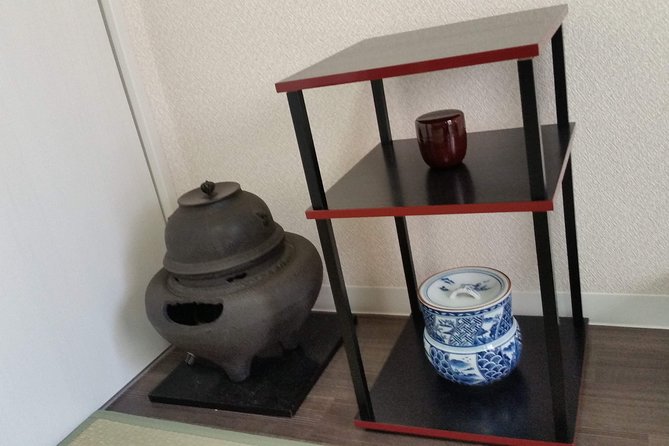
The history and origins of the tea ceremony (Japanese Sadou) can be traced back to ancient Japan. This centuries-old tradition is deeply rooted in Japanese culture and continues to be practiced to this day. However, the tea ceremony isn’t unique to Japan. Similar rituals can be found in different countries, such as China, Korea, and India, each with their own unique variations and cultural significance.
In popular culture, the tea ceremony has gained recognition worldwide, appearing in films, literature, and art. Its serene and graceful nature has captivated audiences, further elevating its status as an integral part of Japanese identity.
The tea ceremony isn’t simply a beverage preparation; it’s a highly ritualized art form that encompasses elements of hospitality, mindfulness, and respect. The meticulous attention to detail, from the preparation of the tea to the graceful movements of the host, creates a harmonious and meditative experience for both the participants and the audience.
Find more activities and experiences we've covered in Osaka.
Tea Ceremony Rituals
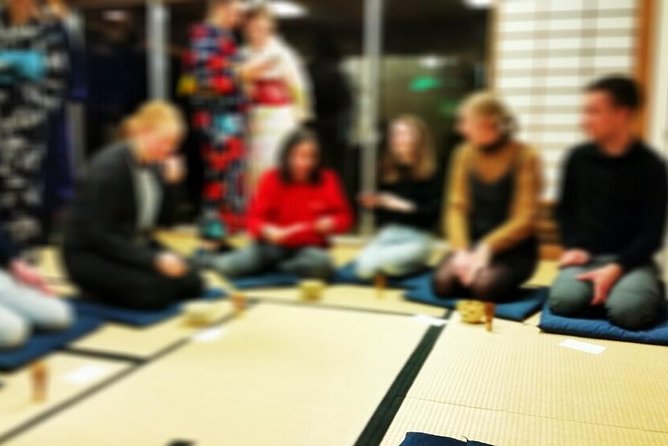
Tea ceremony rituals involve carefully choreographed movements that emphasize grace, mindfulness, and respect. These rituals aren’t just about serving and drinking tea; they’re deeply rooted in tradition and carry significant symbolism. Every aspect of the ceremony, from the preparation of the tea to the way it’s served and consumed, holds cultural significance.
Tea ceremony symbolism is seen in the use of specific utensils, such as the tea bowl, which represents simplicity and humility. The act of whisking the powdered tea in a precise manner symbolizes harmonizing the mind, body, and spirit. The ceremony itself reflects the Japanese concept of ‘ichi-go ichi-e,’ which means ‘one time, one meeting,’ emphasizing the importance of treasuring each moment and cherishing the connections made during the ceremony.
Tea ceremonies have a profound cultural significance in Japan. They provide a space for participants to escape the fast-paced modern world and find tranquility and mindfulness. The rituals promote a sense of harmony, respect, and gratitude towards nature, others, and oneself. Through the art of tea, people can experience a profound connection with the past and appreciate the beauty of simplicity.
Tea Ceremony Tools and Utensils
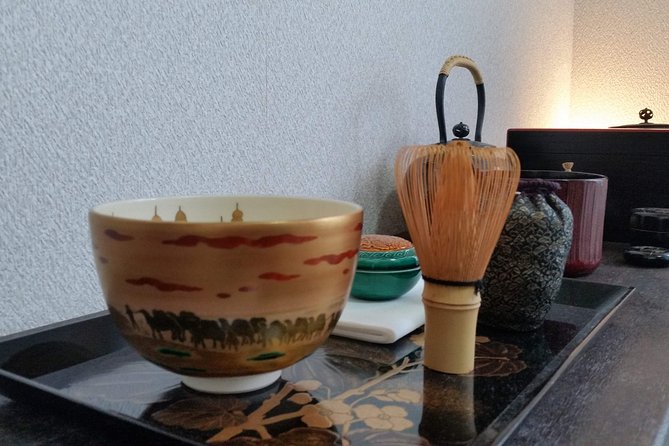
During a tea ceremony, various tools and utensils are used to create an authentic and traditional experience. Japanese tea ceremony tools and utensils play a crucial role in the preparation and presentation of matcha, a powdered green tea that’s central to the ceremony.
One of the most important tools is the chawan, a wide and shallow tea bowl used for whisking the tea. The chasen, a bamboo whisk, is used to mix the tea powder with hot water and create a frothy consistency. Another essential utensil is the chashaku, a bamboo tea scoop used to measure the perfect amount of matcha powder.
Other tools and utensils commonly used in a tea ceremony include the natsume (tea caddy), kensui (waste water bowl), and fukusa (silk cloth used for cleaning). These carefully selected tools and utensils contribute to the graceful and serene atmosphere of the tea ceremony, enhancing the overall experience for both the host and guests.
Tea Ceremony Etiquette
When participating in a tea ceremony, it’s important to adhere to proper etiquette. The tea ceremony is a highly ritualized and formal event, and following the correct etiquette is essential to show respect for the ceremony and the host.
Before entering the tea room, guests must remove their shoes and put on special slippers called ‘zori.’ Once inside, they must bow in respect to the host and the tea utensils.
The guests should also be mindful of their posture and movements during the ceremony. When receiving the tea, they should hold the tea bowl with both hands and take a moment to appreciate its beauty before drinking. It’s also important to compliment the tea and express gratitude to the host.
Different Tea Ceremony Schools
To explore the realm of different tea ceremony schools, one must explore the various traditions and practices that define each unique approach to this revered art form. Within the world of Japanese tea ceremony, there are several prominent schools that have their own distinct methods and philosophies. Here are three key aspects to consider:
Lineage and History: Each tea ceremony school has its own lineage and history, often tracing back several centuries. These lineages contribute to the authenticity and credibility of the school’s teachings.
Techniques and Rituals: The different schools emphasize different techniques and rituals in their tea ceremonies. These can range from the way the tea is prepared and served to the specific movements and gestures performed by the tea host.
Tea Ceremony Competitions: Some tea ceremony schools hold competitions where practitioners can showcase their skills and mastery of the art. These competitions not only promote friendly competition but also serve as a platform for the preservation and advancement of tea ceremony traditions.
The cultural significance of tea ceremony is deeply rooted in Japanese history and aesthetics. It’s seen as a way to cultivate mindfulness, harmony, and respect, as well as a means of connecting with nature and appreciating the beauty of simplicity.
Through the exploration of different tea ceremony schools, one can gain a deeper understanding of the rich cultural heritage and artistic expression that’s embodied in this ancient practice.
- Private Car Full Day Tour of Osaka Temples, Gardens and Kofun Tombs
- Private Arrival Transfer From Kansai Airport to Osaka City
- Osaka Nightlife Tour and Bar Hop
- Kyoto Private Tour (Shore Excursion Available From Osaka or Kobe Port)
- Heart-Warming Japanese in Home Cooking Lesson With a Local Mother in Osaka
- Retro Osaka Street Food Tour: Shinsekai
Tea Ceremony and Zen Buddhism
Tea Ceremony in Japanese Sadou is closely intertwined with Zen Buddhism, emphasizing the principles of mindfulness and simplicity. The tea ceremony, known as ‘chanoyu’ in Japanese, isn’t just a mere act of preparing and serving tea. It’s a meditative practice that encourages participants to be fully present in the moment, cultivating a sense of mindfulness and awareness.
Every movement, from the precise gestures of pouring and whisking the tea to the appreciation of the tea utensils, is done with utmost care and attention. This focus on mindfulness allows participants to escape the distractions of the outside world and find tranquility in the ritualistic process of making and sharing tea.
Plus, the tea ceremony has deep cultural significance in Japan, embodying the values of harmony, respect, purity, and tranquility. It serves as a way to connect with nature, appreciate beauty, and foster social bonds.
Modern Tea Ceremony Practices
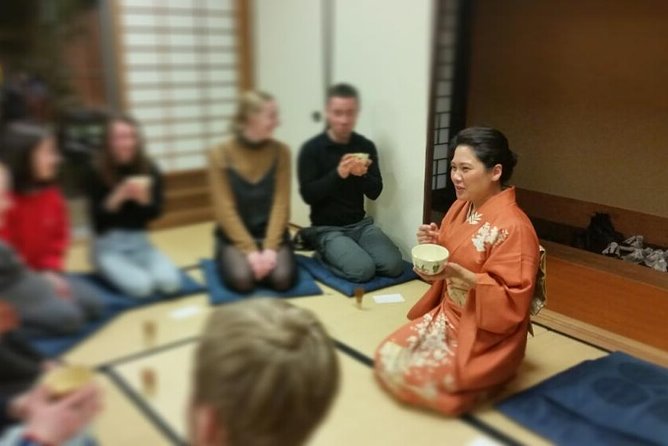
Modern tea ceremony practices have evolved to incorporate contemporary elements while still maintaining the core principles of mindfulness and simplicity. Today, tea ceremonies aren’t only performed in traditional tea houses, but also in modern settings such as cafes and art galleries. These practices have also adapted to accommodate different lifestyles and preferences.
Here are three ways in which modern tea ceremony practices have been influenced:
Inclusion of technology: Some tea ceremonies now incorporate digital elements, such as using electronic kettles or displaying tea-related information on screens.
Fusion with other cultures: Modern tea ceremonies may incorporate elements from other cultures, such as serving matcha-flavored desserts or using Western-style teacups.
Experimentation with attire: While traditional tea ceremony attire consists of kimono and hakama, modern tea ceremonies may allow for more casual or contemporary clothing choices, while still maintaining a respectful and elegant appearance.
These adaptations ensure that tea ceremonies remain relevant and accessible to a wider audience, while still honoring the rich traditions of Japanese tea culture.
Common Questions
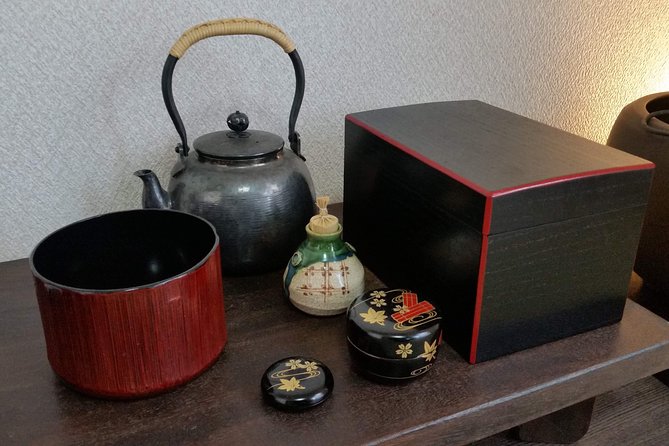
How Long Does a Typical Tea Ceremony Last?
A typical tea ceremony usually lasts around one hour. It is a cultural practice that holds great significance in Japanese tradition, showcasing the art of tea preparation and serving as a means of fostering connection and harmony.
What Is the Significance of the Tea Room’s Design and Layout?
The significance of the tea room’s design and layout in a tea ceremony is to create a harmonious and peaceful atmosphere. The rules and guidelines of the ceremony, along with the traditional attire, are necessary for one to fully participate and appreciate the experience. Knowledge of tea ceremony etiquette is important for attendees, including children.
Are There Any Specific Rules or Guidelines for Attire During a Tea Ceremony?
Attire guidelines for a tea ceremony include a traditional dress code. Guests are expected to wear modest and respectful clothing, such as long sleeves and pants or dresses. Avoid flashy or casual attire to show proper respect for the ceremony.
Can Children Participate in a Tea Ceremony?
Children of all ages can participate in a tea ceremony, seeing the rich traditions and rituals. From learning how to prepare and serve tea to experiencing the serene atmosphere, it’s a wonderful opportunity for young ones to engage in this cultural experience.
Is It Necessary to Have Prior Knowledge or Experience With Tea Ceremonies to Attend One?
Attending a tea ceremony doesn’t require prior knowledge or experience. Guests can enjoy the traditional Japanese ritual and learn as they go. It’s a unique opportunity to appreciate the art of tea-making.
The Sum Up
To sum it up, the Japanese Tea Ceremony, or Sadou, offers a mesmerizing glimpse into a world of harmony and mindfulness. Through its carefully choreographed rituals and the preparation of matcha, participants are able to cultivate a sense of tranquility and connection.
The Tea Ceremony’s origins in Zen Buddhism and its emphasis on respect and attention to detail make it a truly unique and profound cultural experience. Whether one is a tea enthusiast or simply curious about Japanese traditions, the Tea Ceremony invites all to embrace its beauty and grace.
More Tour Reviews in Osaka
Looking for something different? Other Osaka activities we've written about
- Osaka Kansai Airport to Kanazawa City Private Transfer
- Deep Food Tour & Bar Hopping in Temma, Osaka
- Tea Ceremony Experience in Osaka
- Osaka: Private Food Tour & Bar Hopping in Namba
- Kobe Night View Mt Rokko Kitano Ijinkan Arima Onsen Day Trip
- 2 Hours Karaoke Room With Set Menu and Unlimited Drinks in Osaka
- Osaka Kuromon Market With a Chef!
- 1 Hour Food Tour at the Kuromon Market in Osaka
- Tea Ceremony and Calligraphy Experiences in Osaka
- Kyoto/Osaka: Kyoto and Nara Customized Private Guided Tour
- Osaka 1-Day Private Tour – Osaka Castle, Shinsekai, Dotonbori
- Arashiyama Autumn Leaves & Sanzen-In Temple Tour From Osaka/Kyoto
